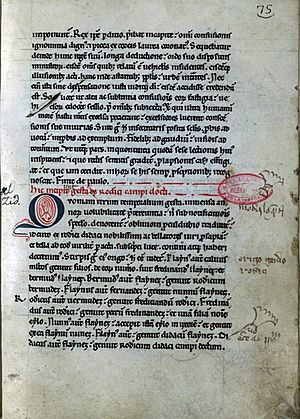Historia Roderici facts for kids

The Historia Roderici is an old Latin book. It tells the story of a famous Spanish hero named Rodrigo Díaz. People also called him El Cid Campeador. This book was first called Gesta Roderici Campi Docti, which means "Deeds of Rodrigo el Campeador." Sometimes, it's known as the Latin Chronicle of the Cid.
Contents
The History of El Cid
This book is written in Latin. It was written by someone whose name we don't know. The writing style is quite simple. The author didn't seem to read many other books. They only mention the Bible once.
What the Book Covers
Modern editors have split the book into 77 chapters. The original book didn't have these chapters. The author knew little about Rodrigo's early life. For example, they didn't know much before he married Jimena. All of his early life is told in the first six chapters.
The book shares more details about Rodrigo's career. This includes his time in exile in Zaragoza from 1081 to 1086. These events are covered in chapters 7 to 24. The book quickly goes over his return to the court of Alfonso VI of León and Castile. This happened between 1086 and 1088. It also quickly covers the years 1095 to 1096. During this time, Rodrigo ruled Valencia.
The biggest part of the book is about his second exile. It also covers his conquest of Valencia. This happened from 1089 to 1095. This section is found in chapters 28 to 64. The last part of the book (chapters 65 to 75) covers Rodrigo's final two years. A short ending (chapters 76 to 77) describes what happened after. It tells how Christians left Valencia in 1102. Rodrigo's wife, Jimena, led this move.
The author admitted that not everything was included. In chapter 27, they wrote: "Not all the wars and warlike exploits which Rodrigo accomplished with his knights and companions are written in this book."
Where the Book Was Found
The oldest copy of this book we have is from the early 1200s. It was found in the late 1700s. This happened at the San Isidoro in León. But it was probably first copied in Castile or La Rioja.
Today, this old copy is in the library of the Real Academia de la Historia in Madrid. This copy also has other old Spanish history books. These include Historia Gothorum by Isidore of Seville and the Chronicle of Alfonso III.
Some mistakes in the Historia Roderici show that this copy is not the original. It is a copy of an earlier version. It might be the copy mentioned in a document from 1239. That document says a copy was made in 1232 or 1233. This happened at the priory of San Zoilo in Carrión de los Condes. It was copied from a book at the monastery of Nájera. But we can't be sure this is the same copy.
When Was It Written?
Historian R. A. Fletcher thinks the Historia was written before 1125. In chapter 23, the person who copied the Madrid book wrote "Súnchez." The correct name should have been "Sánchez." This mistake might have happened because of an old writing style. This style is called Visigothic script.
Visigothic script was common in Spain. But it was disappearing in central Spain by 1125. By the 1140s, it was almost gone. A new script called francesa took its place. This new style came from France. The Visigothic 'a' looked like an open top. This made it look like the French 'u'. So, the person copying the book was probably working from an original written in Visigothic script.
See also
 In Spanish: Historia Roderici para niños
In Spanish: Historia Roderici para niños

